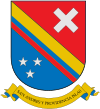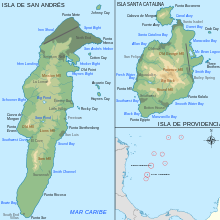San Andrés and Providencia
| Data | |
|---|---|
| Capital | San Andrés |
| governor | Ronald Housni Jaller (2016-2019) |
| surface | 44 km² |
|
Population (Total) - 2005 Census - Population Density |
70,554 1,604 inhabitants / km² |
| urbanization | 70.4% |
| Literacy rate | 94.2% |
| Number of parishes | 2 |
| Popular name | sanandresano |
| Important cities | Providencia |
| map | |
| Location of San Andrés y Providencia in Colombia | |
San Andrés y Providencia ( German San Andrés and Providencia ) is a Colombian department ( Departamento Archipiélago de San Andrés, Providencia y Santa Catalina ) and an archipelago in the Caribbean ( Archipiélago de San Andrés y Providencia ), consisting of the islands of San Andrés , Providencia and Santa Catalina .
geography
The islands are only 200 kilometers off the coast of Nicaragua , but 800 kilometers off the coast of Colombia in the Caribbean. San Andrés and Providencia are about 70 kilometers apart.
The island of San Andrés consists of a mountain range that stretches from north to south and measures 55 meters above sea level at its highest point. The island is mainly characterized by coconut palm forests. The archipelago extends over 349,800 km², but the province only consists of 44 km². In the north and north-east of the island of San Andrés, within three kilometers of the coast, there are some minor islands , such as Cayo Rosa, Cayo Santander and Cayo Rocoso.
The islands of Providencia and Santa Catalina with secondary islands such as Cayo Cangrejo also belong to the archipelago.
Colombia also includes eight atoll-like formations, some of which are also claimed by other states, from south to north:
- Cayos del Este Sudeste (Courtown Cays, Cayos de ESE)
- Cayos de Albuquerque (Cayos de SW, Southwest Cays)
- Roncador
- Quita Sueño (no islands)
- Serrana
- Serranilla
- Bajo Nuevo Bank
- Alice Shoal (flooded bank)
The tourism and trade, dominated by the situation, are the main economic activities of the islands. Agriculture , animal husbandry and fishing are only operated for self-sufficiency.
history
Christopher Columbus discovered the islands on his fourth voyage in 1502, so that the names San Andrés, Santa Catalina and Serrana were already listed on a "universal map" (Carta Universal) in 1527. Spaniards settled San Andrés from 1595. Around 1629, the English settled from Bermuda , then from Barbados and Saint Kitts . By then, the Dutch had already settled on the island. They used the island in the war against the Spanish Empire.
The Seaflower landed in 1631, bringing with it more English and Scottish settlers who were expelled in 1641 when the Spanish retook Providencia. In 1666 and 1670 the pirate captains Edward Mansveldt and Henry Morgan conquered the island and used it as a base. In the following century the island experienced significant economic importance through the export of cotton . In 1870, the population was 3,520, most of whom had immigrated from Jamaica , growing cotton and sugar cane , raising cattle, and exporting coconuts and precious woods.
The islands were administered from 1739 in the province of Veragus ( Panama to the east coast of Nicaragua ), later by the province of Cartagena. After the Republic of Greater Colombia gained independence , it occupied the islands in 1822, and administration was transferred to the Magdalena Province. The Central American Confederation did not recognize this occupation, however, and Greater Colombia protested in return about the occupation of the east coast of modern Nicaragua by the Central American Confederation. However, this dissolved in the civil war of 1838-1840 and the resulting state of Nicaragua continued this dispute.
Colombia introduced self-administration in 1912. The Esguerra-Bácenas Treaty of 1928 meanwhile resolved the conflict between the two countries. Nicaragua later argued that this treaty arose under the pressure and occupation of the United States and was therefore not considered a sovereign decision. Colombia insists on the treaty ratified in 1930, when the US occupation had already ended.
The uninhabited islands Roncador, Quita Sueño and Serrana counted up in the 1980s to the outlying the United States since a 1972 signed agreement to return by the US Senate has not ratified.
In 2001 Nicaragua filed a lawsuit with the International Court of Justice , which includes the border of 50,000 km² including the two islands. Colombia did not recognize the jurisdiction of the International Court of Justice in this case and increased the military presence on the islands. Since then, Colombia has been preparing the process and in 1999 signed a treaty with Honduras that implicitly recognizes Colombia's sovereignty over San Andrés. Nicaragua and Honduras are involved in similar border disputes. On December 13, 2007 the International Court of Justice ruled that the two islands belong to Colombia, this was confirmed by a final decision on November 19, 2012. In the course of the decision, however, the ICJ also established new maritime borders, which represent a significant expansion of the territory for Nicaragua. As a result, Colombia lost 75,000 square kilometers of sea area. Russia later offered military aid to Nicaragua in the event of a conflict. In addition, Colombia has declared that two Russian Tu-160 aircraft had crossed Colombian airspace without a permit in early November 2013 . This resulted in a protest to Russia. However, worried that the country could hold its own in the event of war against Russia, the Colombian Congress summoned Defense Minister Juan Carlos Pinzón and Foreign Minister María Angela Holguín to discuss the matter.
On October 29, 2005, Providencia Island was hit by Hurricane Beta.
Administrative division
The department of San Andrés and Providencia consists of two municipalities. The population figures are based on the 2005 DANE census and extrapolated for 2018.
| local community | Population 2018 |
|---|---|
| Providencia | 5,192 |
| San Andrés | 73.221 |
literature
- Christian Diemer, Amalija Šeparović: Territorial Questions and Maritime Delimitation with Regard to Nicaragua's Claims to the San Andrés Archipelago. In: ZaöRV 66 (2006), pp. 167–186.
Web links
Individual evidence
- ↑ Press release , accessed on January 18, 2013.
- ↑ Press release , accessed on January 18, 2013.
- ↑ www.latina-press.com Russia wants to support Nicaragua militarily in the border dispute with Colombia. November 13, 2013. Accessed February 13, 2014.
- ↑ Russia wants to support Nicaragua militarily in the border dispute with Colombia. November 13, 2013, accessed February 7, 2014 .
- ↑ Extrapolation of the population of Colombia on the official DANE website
Coordinates: 12 ° 33 ′ N , 81 ° 43 ′ W






